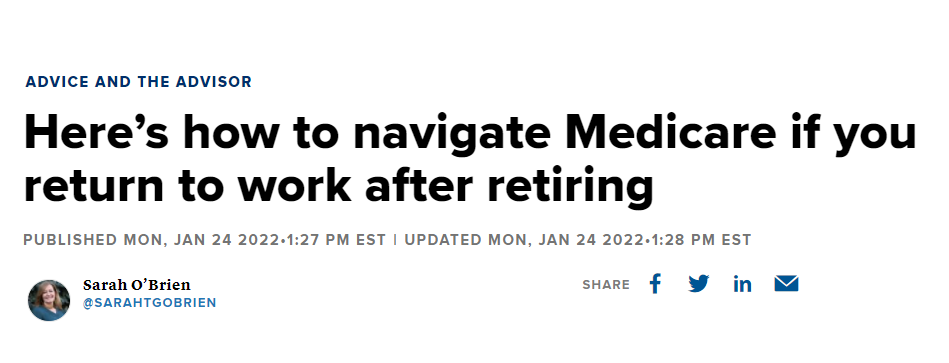|
Some Medicare beneficiaries will be hit with late-enrollment fees in 2022. These charges would be warned of by Congress before they occur, per this recent CNBC article. Here is a summary of the article:
The latest feedback on how to best navigate the Medicare system if you return to the work force can be found in a recent article from CNBC.
The CNBC article explains that if the company you work for employs fewer than 20 people, and you wish to enroll in the Medicare health plan, you will need to stay on Parts A or B. If you go to work for a larger company, different rules apply, but there are some things to consider before you sign up for an employer health plan. There will be new rules and deadlines for you to re-enroll in Medicare. Read the full article here: https://www.cnbc.com/2022/01/24/heres-how-to-navigate-medicare-if-you-return-to-work-after-retiring.html When is open enrollment for Medicare Advantage? How does it work?
How long is open enrollment for Medicare? Every year from January 1 through March 31 current policyholders of Medicare Advantage (MA) plans are eligible to enroll in a different MA plan. How does open enrollment work? MA, or Medicare C, plans can be changed once a year. Those who currently have this type of managed-care alternative to Original Medicare can choose to keep the same plan, to opt into a different Advantage plan, or to enroll in Medicare A, or Original Medicare. If you decide to drop your MA plan in favor of Medicare A you may not be able to buy a supplemental Medigap plan. Who is eligible for open enrollment? This open enrollment period is only for people who already have an Advantage plan. What are Medicare parts A, B, C, and D? Medicare A is hospital insurance. Premium-free Part A is available to people who meet the criteria. To qualify for premium-free Part A:
Whether or not you have a monthly premium, the benefits are the same, including deductibles and coinsurance. If you choose Part A, you must also:
Medicare Part B Part B is optional medical insurance with a monthly premium. After the deductible is met, you’ll typically pay 20% for most doctor services. Included are inpatient hospital stays, outpatient therapies, and durable medical equipment (DME). Enrolling in Part B when you’re eligible for Medicare will save you a late enrollment penalty. Medicare Part C Medicare Advantage plans, (MA or Medicare Part C), is Managed Care, very much like most employer-offered insurance. MA plans combine parts A and B, and 90% of MA plans include drug coverage (Part D). Medigap plans insurance can’t be used for MA plans, as they’re unnecessary. Talk about one-stop shopping! Medicare Part D Medicare Part D is available as a separate policy for prescriptions only. Choosing a drug plan at the time you enroll in Medicare, even if you don't currently take medications, will avoid a possible late enrollment penalty if you do eventually need drug coverage; late enrollment penalties will increase your monthly premium. The pros and cons Medicare Advantage Plans may have rules that are different from Original Medicare. However, in keeping with CMS rules, your plan must give you at least the same coverage as Original Medicare. Some services may only be covered in a particular facility or for patients with certain conditions. Some MAs offer more comprehensive plans to fit your needs: many cover over-the-counter medications or gym memberships. The takeaway Carefully research your options; compare your needs to each plan’s offerings before enrolling. Very rare circumstances will permit a change before the open enrollment period begin. |
Ted CzabanowskiLicensed Insurance Agent in Rhode Island Archives
March 2024
Categories |



 RSS Feed
RSS Feed